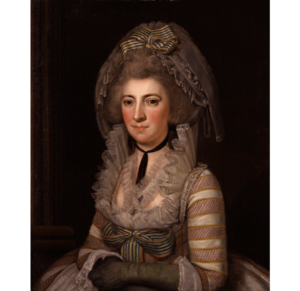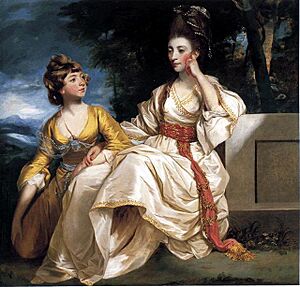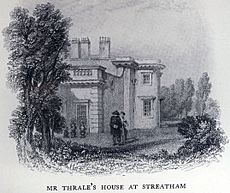Hester Thrale facts for kids
Quick facts for kids
Hester Thrale Piozzi
|
|
|---|---|

Hester Thrale in 1786
|
|
| Born |
Hester Lynch Salusbury
27 January 1741 Caernarvonshire, Wales
|
| Died | 2 May 1821 (aged 80) Clifton, Bristol, England
|
| Other names | Hester Salusbury, Hester Piozzi |
| Spouse(s) | Henry Thrale (m. 1763), Gabriel Mario Piozzi (m. 1784) |
Hester Lynch Thrale Piozzi (born Hester Lynch Salusbury; later Piozzi; 27 January 1741 – 2 May 1821) was a Welsh writer. She kept a detailed diary and wrote many books. She is a very important source of information about the famous writer Samuel Johnson and what life was like in England during the 1700s.
Hester came from a well-known Welsh family. She first married a rich brewer named Henry Thrale. After he passed away, she married Gabriel Mario Piozzi, who was a music teacher. Her books, Anecdotes of the Late Samuel Johnson (published in 1786) and her diary Thraliana (published much later in 1942), are her most famous works. She also wrote a history book, a travel book, and a dictionary. Many people see her as an early supporter of women's rights.
Contents
Hester's Early Life and Education

Hester Lynch Salusbury was born in Wales at Bodvel Hall. She was the only daughter of Hester Lynch Cotton and Sir John Salusbury. Her family, the Salusbury family, was one of the most important land-owning families in Wales during the 1700s. She was even related to Katheryn of Berain, a famous Welsh noblewoman.
Hester received a very good education for a young woman of her time. Her uncles paid special attention to her learning. She later said that they taught her to read, speak, think, and translate French so well that she was "half a prodigy." This means she was very talented and smart for her age.
Hester's Marriages and Social Life
First Marriage to Henry Thrale
Hester's father faced financial difficulties. To help her family, Hester married Henry Thrale on 11 October 1763, in London. Henry was a very wealthy brewer. They had twelve children together and lived in a large home called Streatham Park. Their marriage had its challenges, but Hester gained freedom to meet many interesting people.
Because of her husband's wealth, Hester was able to join London's high society. She met many famous writers and thinkers of the time. These included Samuel Johnson, James Boswell, Oliver Goldsmith, and the young writer Frances Burney. Hester became good friends with Frances Burney and often spent time with her.
Samuel Johnson often visited Hester and Henry at their home. He even had his own room there. In 1774, Johnson traveled with Hester to Wales. They visited Hester's uncle, Sir Lynch Cotton. People noticed that Johnson was sometimes rude, but he was also very charming when telling stories.
Johnson wrote two poems for Hester in 1775. One was for her 35th birthday, and the other was in Latin to honor her.
Frances Burney wrote in her diary about the lively conversations at Hester's parties. She described a young woman named Miss Sophy Streatfeild. Hester sometimes felt a bit annoyed that Sophy got so much attention from the men. But Hester also showed her funny side. She once said that Sophy could "cry herself into any of your hearts she pleased." Hester even made Sophy cry to show Frances how beautiful she looked in tears!
In 1780, Hester and Henry were in Bath during the Gordon Riots. These riots involved attacks on Catholic buildings. They were worried about Henry's brewery in London, but it was safe.
Henry Thrale passed away on 4 April 1781. Hester was very sad and had to manage selling his brewery. Frances Burney was there to support her during this difficult time.
Second Marriage to Gabriel Piozzi
A few years later, Hester fell in love with Gabriel Mario Piozzi. He was an Italian music teacher who had taught her children. They married on 25 July 1784. This marriage caused some people to criticize Hester. Some newspapers wrote unkind things, saying she had "disgraced" herself by marrying a "penniless Fiddler."
This marriage also caused a disagreement with Samuel Johnson. They made up shortly before he died. Other friends, like Frances Burney, also disapproved at first. After their wedding, Hester and Gabriel traveled around Europe for three years, especially in Italy. They followed the traditional "Grand Tour" route. In 1795, Hester and Gabriel moved to a new house called Brynbella in north Wales.
Hester's Written Works
After Samuel Johnson died, Hester published Anecdotes of the Late Samuel Johnson in 1786. She also published their letters to each other in 1788.
Frances Burney read Hester's book before it was published. She felt that Hester had shared too much. Frances thought that while Hester meant to be fair to Johnson, she actually harmed his memory by revealing everything.
Hester also kept detailed diaries called Thraliana. These diaries were not published until 1942. Together with her Anecdotes, these writings help us understand Samuel Johnson better. They offer a different view from James Boswell's famous Life of Samuel Johnson, which some people think was biased. Johnson and Hester had a very close friendship. After Henry Thrale died, many people thought Johnson would marry Hester.
Hester also wrote Observations and Reflections made in the Course of a Journey through France, Italy, and Germany (1789). This book described her travels with Gabriel during their honeymoon. It was one of the first travel books written by a British woman in a story format, not just as letters. Even Queen Charlotte read it!
Her book Retrospection... (1801) was a history book for a general audience. However, critics did not like it much. Some reviewers were unfair because she was a woman writing history, which was usually a male field. They also made fun of her age. One person called it "a series of dreams by an old lady."
Today, people think more highly of Retrospection. It is now seen as an early example of "feminist history." It looked at how manners and customs changed, especially for women.
Hester was also a lexicographer, someone who writes dictionaries. Her book British synonymy, or, An attempt at regulating the choice of words in familiar conversation was published in 1794. This was ten years after Samuel Johnson, who was also a famous lexicographer, had died.
Death and Lasting Impact
Hester Piozzi died in Clifton, Bristol, on 2 May 1821. She had complications after a fall. She was buried on 16 May 1821 next to Gabriel Piozzi in the churchyard of Corpus Christi Church in Tremeirchion, Wales. A marble plaque was placed inside the church in 1909 to honor her.
Frances Burney praised Hester after her death, comparing her to the famous writer Germaine de Staël.
For a long time after her death, scholars called her "Mrs Thrale" or "Hester Thrale." But today, she is often called Hester Lynch Piozzi or Mrs Piozzi.
The writer Samuel Beckett used Hester's diaries and Anecdotes for a play he started writing. It was about her relationship with Johnson.
The author Lillian de la Torre included Hester Thrale in one of her mystery stories. In these stories, Samuel Johnson acts as a detective.
An opera called Johnson Preserv'd was written about Hester and Samuel Johnson. It was performed in London in 1967.
See also
- Salusbury Family
- John Salusbury Piozzi Salusbury – adopted son
- Lleweni Hall


